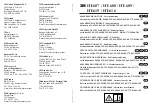
6
E4PA-N
Ultrasonic Displacement Sensor
Safety Precautions
■
Precautions for Safe Use
Design
Power Supply
If possible, use a power supply without overcurrent detection. This
Sensor uses a DC-DC converter in the power supply circuit. If the
power supply has overcurrent detection, the protective circuit may be
activated by the inrush current.
Recommended power supply: OMRON S82-series Power Supply
(Capacity: 15 W min.)
Wiring
Power Supply Voltage
Do not exceed the operating voltage range. Using a higher voltage
or using an AC power supply (100 VAC or more) for a DC Sensor
can cause explosion or burning.
Faulty Wiring
Be careful not to make wiring mistakes such as reversing the power
supply polarity. Faulty wiring can cause explosion or burning.
Operating Environment
Do not use the Sensor in an environment where inflammable or
explosive gas is present.
Others
• Do not attempt to disassemble, repair, or modify any Units. Any at-
tempt to do so may result in malfunction, fire, or electric shock.
• Dispose of Sensors as industrial waste.
■
Precautions for Correct Use
Design
Sensor Ambient Temperature and Humidity
The acoustic velocity generally fluctuates approximately 0.17% with
each 1
°
C of temperature change. For example, if the ambient tem-
perature increases from 20 to 40
°
C, then the acoustic velocity will
increase by 3.5%. Moreover, the acoustic velocity will increase by
2% in dry air compared with air with 100% humidity. Test the environ-
mental conditions where the Sensor will actually be used.
Mutual Interference
The mutual interference prevention function can be used with up to
five Sensors in close proximity. Separate the Sensors as specified in
the following table when using two or more Sensors in close proximity
without using the mutual interference prevention function.
Parallel Arrangement
Note:
The values shown in the following table are examples for ref-
erence only. The actual values will vary depending on the sur-
face conditions of the sensing object, and on the ultrasonic
waves that are reflected. Moreover, if the sensing object is in-
clined, the Y value in the table will be increased further.
Facing Arrangement
Sensing Object
• The sensing object may be solid, liquid, or powder, and the detec-
tion capability of the Sensor will vary depending on the surface con-
ditions of the object. If the surface irregularities are no more than 0.2
mm, then the specified sensing distance will apply. Materials such
as fine powder, felt, cotton, and other materials that absorb sound
should be tested before using the Sensor.
• If the surface temperature of the sensing object is over 100
°
C, there
will be very little ultrasonic reflection. Conduct tests before using the
Sensor.
Influence of Sensing Angle
Ultrasonic Displacement Sensors can detect solid, liquid, or powder
sensing objects, but the surface of the sensing object will affect the
measurement. Dented surfaces or sensing objects with an angled
surface require a tilt angle within 3
°
max. to achieve accurate sens-
ing.
Installation
Mounting the Sensor
The Sensor must be mounted using the nuts provided, and tightened
to a torque of 15 N·m max.
If the Sensor malfunctions due to noise, insert insulation between
the Sensor and the mounting base (metal).
Atmosphere
• To ensure reliability and long service life, do not use the Sensor out-
doors or in places that exceed the rated temperature.
• Ultrasonic sensors use air as the transmission medium, so if there
are local temperature differences there may be malfunctioning due
to reflection and refraction at the boundaries, and the detection dis-
tances change where wind blows. Therefore, the Sensor should not
be used near equipment such as forced-air ventilators.
• Jets from air nozzles include various frequencies, so they can affect
the Sensor and should not be used nearby.
• Water drops on the Sensor surface shorten the sensing distance.
Wiring Considerations
Cable Length
The cable must be no longer than 10 m.
High-voltage Lines
Do not lay power supply cable for the E4PA-N Ultrasonic Displace-
ment Sensor together with high-voltage lines or power lines. Placing
them in the same conduit or duct may result in interference, damage,
or malfunction.
Model
Y
E4PA-LS50-M1-N
0.3 m min.
E4PA-LS200-M1-N
1 m min.
E4PA-LS400-M1-N
2 m min.
E4PA-LS600-M1-N
2.5 m min.
Y
E4PA-N
E4PA-N
Sensing object
Sensing object
Model
Y
E4PA-LS50-M1-N
2 m min.
E4PA-LS200-M1-N
8 m min.
E4PA-LS400-M1-N
16 m min.
E4PA-LS600-M1-N
25 m min.
X
E4PA-N
E4PA-N
3
°
3
°
E4PA-N
Sensing object
Downloaded from
Downloaded from
Downloaded from
Downloaded from
Downloaded from
Downloaded from



























